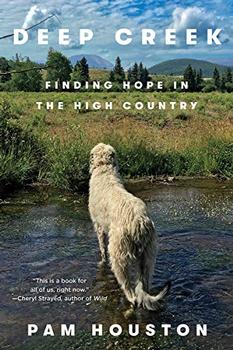Summary | Excerpt | Reviews | Beyond the Book | Readalikes | Genres & Themes | Author Bio

Finding Hope in the High Country
by Pam HoustonRanch Almanac: Carving Rivers
Today I'll spend three hours carving rivers through ice with a pointed shovel and a maul, and by the day's end I'll have the blisters to prove it. It's to do with Deseo, who finds all manner of things scary and off- putting. Purple buckets, flapping jackets, the wind whispering through the pines.
The trough where the horses drink in winter is at the end of the pasture where all the water from the snowmelt drains toward Lime Creek. The trough is there because that's where the frost- free hydrant is, and the frost- free hydrant is there because it's the closest point to the house from which the water originates. The longer the line from the house to the frost- free hydrant, the higher the chance of the system freezing, and then we go back to hauling water again.
Unfortunately, when we get into the freeze- and- melt portion of the winter, which can last from early March to mid- May, a pond develops around the trough, which turns into a skating rink every time the temperature dips below 30, which is to say, every single night. And to Deseo, a skating rink surrounding a horse trough might be the scariest thing of all.
When Deseo doesn't drink, his metabolic condition gets worse. When he refuses to cross the ice, I carry a bucket of water out to him. Sadly, then, the bucket becomes the object of his fear. I can leave it on the ground and walk away to prove it is neither strange nor alive; I can float little bits of carrot on the surface of the water to make it more enticing; I can even get on my hands and knees and pretend to slurp some of the water up into my mouth myself, but he simply won't have it. He feels there is only one designated safe place to drink in this pasture and that is the water trough, the water trough now booby- trapped by a nonnegotiable platform of ice.
So I wait until the temperature crawls above freezing— about noon— and head to the pasture with my tools. The sun has felt truly warm all week, but this ice that formed on the bottom of what used to be deep snow has had a good four months of subzero to harden. I jump up and down as hard as I can and kick at it with my steel- toed boots and about detach my arms from my shoulder blades wielding the maul over my head to shatter the surface (this part is fun, how it must feel to break a car's windshield). Once pits and cracks begin to form, I dig little tributaries into the ice with the tip of my shovel.
In about thirty minutes, it has warmed up a few more degrees, and I get a satisfying little trickle to flow downhill, out of the skating rink, around the trough and into the yard. I hack some more, the thermometer ticks up another degree, and the water does what water does best— gives in to gravity. I follow it, assisting with a few hacks of my shovel all across the front of my property. Before too long, I have the world's smallest river flowing from the bottom of my pasture, all the way across the yard, and into Lime Creek. I watch the creek water tumble toward the Rio Grande, imagine it running past the town of Creede, and then through Wagon Wheel Gap, down the canyon and across the San Luis Valley, through the Box near Taos, eventually forming the border between Texas and Mexico and flowing into the Gulf. I am filled with a completely disproportionate sense of satisfaction. For a second, I understand why those guys were crazy enough to think they could build the Panama Canal.
I return to the trough and hack my way to another tiny river, and then another one, learning quite a bit about the various properties of water and ice in the process. Once I get the little rivers started, for instance, they deepen and widen and hasten on their own, just like I learned in geology class. Two cubic feet per second turn into twenty with a little more sun and little more coaxing. In three hours I have ten outlet rivers carved into the ice surrounding the trough, and I am starting to develop blisters on my blisters. But the sun is still up and snow is in the forecast and I love my old nervous horse, so I cut five more rivers around the far edges of the ice just in case the pond gets even bigger.
Reprinted from Deep Creek by Pam Houston. Copyright © 2019 by Pam Houston. Used with permission of the publisher, W.W. Norton & Company, Inc. All rights reserved
Harvard is the storehouse of knowledge because the freshmen bring so much in and the graduates take so little out.
Click Here to find out who said this, as well as discovering other famous literary quotes!
Your guide toexceptional books
BookBrowse seeks out and recommends the best in contemporary fiction and nonfiction—books that not only engage and entertain but also deepen our understanding of ourselves and the world around us.